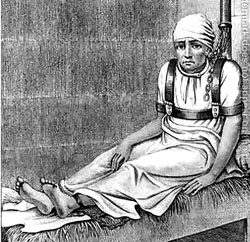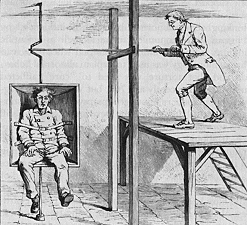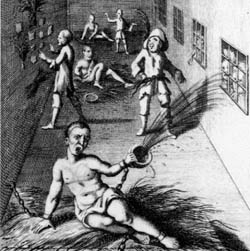| |
|
|
…a rod is for the back of him
that is void of understanding.
|
|
Proverbs 10:13
|
According to Christians, lunatics were possessed by unclean
spirits. To effect a cure it was therefore necessary to dislodge
the offending spirit. This idea derived from gospel stories
of exorcisms.
And there was in their synagogue a man with an unclean spirit;
and he cried out , Saying, Let us alone; what have we to do
with thee, thou Jesus of Nazareth? art thou come to destroy
us? I know thee who thou art, The Holy One of God. And Jesus
rebuked him, saying, Hold thy peace, and come out of him.
Mark 1:23-25
Such beliefs had at least two unfortunate consequences. The
first was that for many centuries no advance was made in understanding
the nature of mental illness — although it is clear that
Christians did understand the there was such a thing as insanity*.
The second was that many thousands of men, women and children,
already burdened with madness, were confined in chains and subjected
to routine torture. The idea was that by making the environment
sufficiently uncomfortable, the torturers might induce the possessing
spirit to leave its human host.
|
Saint Benedict beats a possessed monk,
driving out the demon who possessed him.
Fresco by Spinello Aretino (detail), Basilica San Miniato
al Monte, Florence, Italy
|
|
|
In some monasteries, the monks whipped their insane charges
regularly every day. Although the method was spectacularly unsuccessful,
no one seems to have realised the fact for many centuries. Sometimes
the insane were beaten out of the parish with quarterstaffs.
Sometimes they were loaded onto ships and sent off to die or
become a problem for someone else. This is the origin of the
various popular tales about a "ship of fools".
|
A ship of fools. Those abord will almost
certainly die - through accident, murder, starvation or
shipwreck. This was an ideal way to kill the insane without
feeling guilty. Christians could excuse themselves with
the belief that if the insane they had forced aboard died,
it must have been will.
|
|
|
  For
as long as the Church controlled the insane, they endured dreadful
torments. They were imprisoned, chained to a wall (or if they
were lucky to a bed), flogged, starved, insulted, tortured,
immersed in iced water and otherwise brutalised. It also seems
safe to assume that sexual abuse would have been commonplace
in view of twentieth century disclosures about monasteries,
seminaries, church schools, orphanages and state mental asylums.
Throughout Christendom the insane were kept in insanitary conditions
in mad-houses and exposed to public ridicule. The most famous
place in England for such people was the hospital of St Mary
of Bethlehem ("Bedlam"), where visitors were charged
a fee to see the inmates, and were allowed to provoke them and
laugh at them. A few inmates came to their senses, some died
of old age, some died of neglect, starvation, exposure or torture,
and many died of "putrid fever" or other infectious
diseases that flourished in such conditions. For
as long as the Church controlled the insane, they endured dreadful
torments. They were imprisoned, chained to a wall (or if they
were lucky to a bed), flogged, starved, insulted, tortured,
immersed in iced water and otherwise brutalised. It also seems
safe to assume that sexual abuse would have been commonplace
in view of twentieth century disclosures about monasteries,
seminaries, church schools, orphanages and state mental asylums.
Throughout Christendom the insane were kept in insanitary conditions
in mad-houses and exposed to public ridicule. The most famous
place in England for such people was the hospital of St Mary
of Bethlehem ("Bedlam"), where visitors were charged
a fee to see the inmates, and were allowed to provoke them and
laugh at them. A few inmates came to their senses, some died
of old age, some died of neglect, starvation, exposure or torture,
and many died of "putrid fever" or other infectious
diseases that flourished in such conditions.
The idea that demons caused insanity as well as physical illnesses
was not restricted to the Catholic Church. Here is Martin Luther
on the subject:
My opinion of lunatics is, that all idiots and insane persons
are possessed by devils, though on that account they will
not be damned; but I think Satan tries men in different ways,
some severely, some lightly, some for a long time, some for
a short one. Physicians may attribute such things to natural
causes, and sometimes cure them by medicene, but they are
ignorant of the power of devils.
(personal letter written by Martin Luther to Wenzel Link,
dated July 14, 1528)
Luther goes on to say that because Jesus healeed sick people
with demons, he is "forced to believe that many are made
dumb, deaf, and lame by Satan's malice," and he also supposes
that demons can cause other kinds of sickness and even storms
or blight.
The word bedlam, meaning uproar and confusion, is derived from
the name of the Bethlem Royal Hospital.. The hospital became
a modern psychiatric facility, but historically it was representative
of the worst excesses of asylums in the era of lunacy reform.
The position of master of Bedlam was a sinecure largely regarded
by its occupants as means of profiting at the expense of the
poor in their charge. The 1598 visitation by the Bridewell Governors
had observed that the hospital was "filthely kept".
Up until the seventeeth century the Board of Governors referred
to the inmates as either "the poore" or "prisoners".
An inspection by the Governors in 1631 reported that the patients
were "likely to starve". Inmates left in their cells
with their own excreta were, on occasion, liable to throw "filth
& Excrem[en]t" into the hospital yard or onto passing
staff and visitors. Affluent Londoners could go to see the unfortunate
inmates, to laugh at them, abuse them, or watch them being tortured.
Outings to see them were so commonplace as not to need explanation.
Samuel Pepys' diary for 19 February 1669 for example notes that
"All the afternoon I at the Office, while the young people
went to see Bedlam".
Nepotistic appointment practices played a significant role
in allocating posts. The election of James Monro as Bethlem
physician in 1728 marked the beginning of an 125-year Monro
family dynasty extending through four generations of fathers
and sons. In 1758 William Battie, a former Governor at Bethlem,
published his Treatise on Madness which castigated Bethlem
as archaic and outmoded, uncaring of its patients and founded
upon a despairing medical system whose therapeutic transactions
were injudicious and unnecessarily violent. Bethlem was best
known for the fact that it allowed admittance for a fee to casual
visitors with no connection to the hospital's inmates. This
display of madness as public show has often been considered
the most scandalous feature of the historical Bedlam. "Swarms
of People" descended upon Bethlem during public holidays.
The Governors actively sought out "people of note and quallitie"
as visitors, presumably because they were prepared to pay higher
fees. The practice was never officially recognised (or accounted
for), and probably grew out of the ancient monastic custom of
giving alms to the poor. The spectacle of Bethlem was also thought
to offer moral instruction for visitors, providing a deterrent
by demonstrating the dangers of immorality and vice. For proponents
of lunacy reform, a Quaker-run York Retreat, founded in 1796,
functioned as an exemplar of the new civilised approach. Bethlem,
still embroiled in scandal over its inmate conditions, symbolised
its antithesis.
|
Hogarth's depiction of Bedlam from A
Rake's Progress.
The well-dressed ladies in the background are not inmates,
but visitors, there to amuse themselves.
|
|
|
The Christian Church fiercely opposed the idea that insanity
might have a physical cause, since it knew for a fact that it
was attributable to evil spirits, and the Bible confirmed that
beating was the correct treatment:
A whip for the horse, a bridle for the ass, and a rod for
the fool's back.
Proverbs 26:3
|
Insanity was recognised and accepted
if the sufferer was sufficiently powerful.
Charles the Mad (King Charles VI of France) for example
believed himself to be made of glass and murdered a number
of his own knights.
Detail of Corronation of Charles VI
|
|
|
  In
practice, Christian mental asylums were often used as prisons.
Anyone that the Church did not like, or did not approve of,
could be imprisoned without trial in an asylum, and then tortured
and abused at will. Victims ranged from critics of Church excesses
(including political radicals and atheists) to unmarried mothers,
as well as the genuinely insane. In
practice, Christian mental asylums were often used as prisons.
Anyone that the Church did not like, or did not approve of,
could be imprisoned without trial in an asylum, and then tortured
and abused at will. Victims ranged from critics of Church excesses
(including political radicals and atheists) to unmarried mothers,
as well as the genuinely insane.
The insane were not only a source of public entertainment,
they were also an object lesson as to where immorality could
lead. In France the devout Parisian bourgeoisie enjoyed Sunday
excursions to Bicêtre to watch the insane perform tricks.
By flicking a whip an attendant would make them dance and perform
acrobatics like monkeys at a circus. For churchmen the main
problem was not to reform such institutions, but to ensure that
they were used to deliver the correct moral message to the spectators.
|
"Popular Mode of Curing Insanity"
|
|
|
Here is the Abbé Desmonceaux writing on National
Benevolence in 1789 describing his idea of an asylum that
could be used to illustrate the effects of immorality:
The sight of these shadowy places and the guilty creatures
they contain is well calculated to preserve from the same
acts of just reprobation the deviations of a too licentious
youth; it is thus prudent of mothers and fathers to familiarize
their children at an early age with these horrible and detestable
places, where shame and turpitude fetter crime, where man
corrupted in his essence, often loses forever the rights he
had acquired in society*.
Around 1800 traditional Christian mad houses started being
replaced by lunatic asylums where, at least in some institutions,
attempts were made to provide medical help and effect cures.
This was a break with tradition as Church run mad houses have
existed only to restrain potentially dangerous people, and attempts
at cures had been limited to various tortures designed to expel
the demons possessing them and responsible for their afflictions.
  The
Church lost its power in France during the French Revolution,
and mad-houses soon became a thing of the past. A wide range
of abuses ended as a direct result of the Declaration of
the Rights of Man: "No man may be arrested or detained
except in the cases determined by law and according to the forms
therein prescribed…The law must permit only the penalties
strictly and evidently necessary.... ". By a decree of
1790 the insane who had been confined in religious houses, houses
of correction and elsewhere were to be examined by a magistrate
to establish whether they really were mad. Those who were not
mad were to be released and those who were mad were to be transferred
to hospital*. Humane treatment
of the insane was pioneered in France by Philippe Pinel. He
was appointed to the asylum at Bicêtre in 1793 under the
new secular government. One of his first acts was to remove
the chains from the inmates. He then went on to unchain the
women at the insane asylum for women in Paris. The
Church lost its power in France during the French Revolution,
and mad-houses soon became a thing of the past. A wide range
of abuses ended as a direct result of the Declaration of
the Rights of Man: "No man may be arrested or detained
except in the cases determined by law and according to the forms
therein prescribed…The law must permit only the penalties
strictly and evidently necessary.... ". By a decree of
1790 the insane who had been confined in religious houses, houses
of correction and elsewhere were to be examined by a magistrate
to establish whether they really were mad. Those who were not
mad were to be released and those who were mad were to be transferred
to hospital*. Humane treatment
of the insane was pioneered in France by Philippe Pinel. He
was appointed to the asylum at Bicêtre in 1793 under the
new secular government. One of his first acts was to remove
the chains from the inmates. He then went on to unchain the
women at the insane asylum for women in Paris.
|
Dr. Philippe Pinel releasing male lunatics
from their chains at the Bicêtre Asylum in Paris,
painting by Charles Louis Lucien Müller (1815-1892)
|
|
|
|
Dr. Philippe Pinel at the Salpêtrière,
1795 by Tony Robert-Fleury.
It shows Pinel ordering the removal of chains from patients
at Pitié-Salpêtrière Hospital,
the Paris Asylum for insane women.
|
|
|
  In
Britain the idea of a proper hospital or asylum, as opposed
to the traditional mad-house, was introduced by William Tuke,
a Quaker, who founded a retreat near York in 1794. The institution
was more like a farm with a great walled garden than a prison.
There were no grilles or bars on the windows, and like Pinel,
Tuke removed the chains from his patients. In
Britain the idea of a proper hospital or asylum, as opposed
to the traditional mad-house, was introduced by William Tuke,
a Quaker, who founded a retreat near York in 1794. The institution
was more like a farm with a great walled garden than a prison.
There were no grilles or bars on the windows, and like Pinel,
Tuke removed the chains from his patients.
By the early nineteenth century Parliament was investigating
the Bethlehem Hospital and its traditional practices. In 1815,
for one penny it was still possible each Sunday to watch the
insane perform their tricks to the insults and mocking laughter
of the devout*.
|
Mask for the criminally insane.
Such masks, called torture masks, have long been used
during Christian times to punish criminals.
|
|
|
| |
|
James (William) Norris, Bethlem Patient,
1815.
It was thie case of Norris, exposed by a newspaper, that
led to the reform of Bedlam.
|
|
|
| |
|
Utica Crib - An adult-size restraint
bed used in a New York insane asylum, 1882
Use of the “Utica Crib” began in the 1840s at
Utica, and spread throughout the United States to other
mental institutions. It was widely used to confine patients.
Some cribs were made out of wood, some iron. The sides
and lid were made of spindles, which allowed airflow.
The Utica Crib had a lid, which could be fastened over
the patient. The person restrained could not sit up, nor
get out. The bottom was cushioned with layers of straw.
|
|
|
| |
|
Patient in restraint chair at the West
Riding Pauper Lunatic Asylum, Wakefield, Yorkshire, ca.
1869, ,Photographed by Henry Clarke, Wellcome Library,
London (L0019069, Library reference no.: Iconographic
Collection 347834)
|
|
|
| |
| |
Secular ideas triumphed in the nineteenth century. Abuses were
suppressed as the Churches lost their influence, and soon people
were asking in wonder how it could be that previously "No
one blushed to put the insane in prison"*.
|
This is a mental patient in a Victorian
mental asylum. The Christian treatment of mental patients
frequently immitated the historical treatment of offenders
against the Church: they were imprisoned, chained or held
in painful restraints, flogged and tortured in a variety
of ways, denied ordinary comforts like heat, light, company,
and food and drink, and sometimes exhibitted to public
ridicule.
|
|
|
Modern psychiatric hospitals evolved slowly from Victorian
lunatic asylums, becoming progressively less terrifying as they
became progressively more secular, more humane and more medically
based, and as their religious origins retreated ever further
into the past.
More social issues:
|
|
|
|
|
|
|
|
|
|
|
|
|
|
|
|
|
|
|
|
|
|
|
|
|
|
|
|
|
|
|
|
|
|
|
|
|
|
Buy the Book from Amazon.com
|
|
|
|
|
|
Buy the Book from Amazon.co.uk
|
|
|
| |
| |
| More Books |
|
|
|